Before all the crazy wrenching projects, before my engineering deep-dives, and well before I started The Autopian, I began at Jalopnik as a staff writer in July of 2015, two months prior to VW being caught for Dieselgate emissions cheats (a decade ago today!). As a young reporter and former engineer fascinated by the whole story, I decided to dive deep into Dieselgate, ultimately becoming one of America’s leading reporters on Volkswagen’s emissions scandal. Here’s what it was like reporting Dieselgate as it happened.
The United States District Court of the Northern District of California handled the Dieselgate trial, with Lieff, Cabraser, Heimann & Bernstein representing VW and Audi owners in what would become the biggest automotive class action settlement in American history — $14.7 billion.
I remember everyone — especially VW owners — being confused by what was going on. Many loved their cars, and feared that handing them back to VW as part of some kind of repair program might affect what they saw as a fantastic, fuel-efficient, torquey and reliable vehicle. The Department of Justice, and of course many American citizens, wanted the cars cleaned up and they wanted VW to have to pay dearly. Trying to handle a buyback of that scale — roughly half a million cars — was an incredibly complex endeavor for the lawyers involved, and the result was historic.
I Noticed People Stripping Cars Before The Buyback, And The Court Noticed Me Noticing
The stories that I remember most vividly include this one about folks stripping their cars so they could make a but of extra money on top of VW’s buyback:
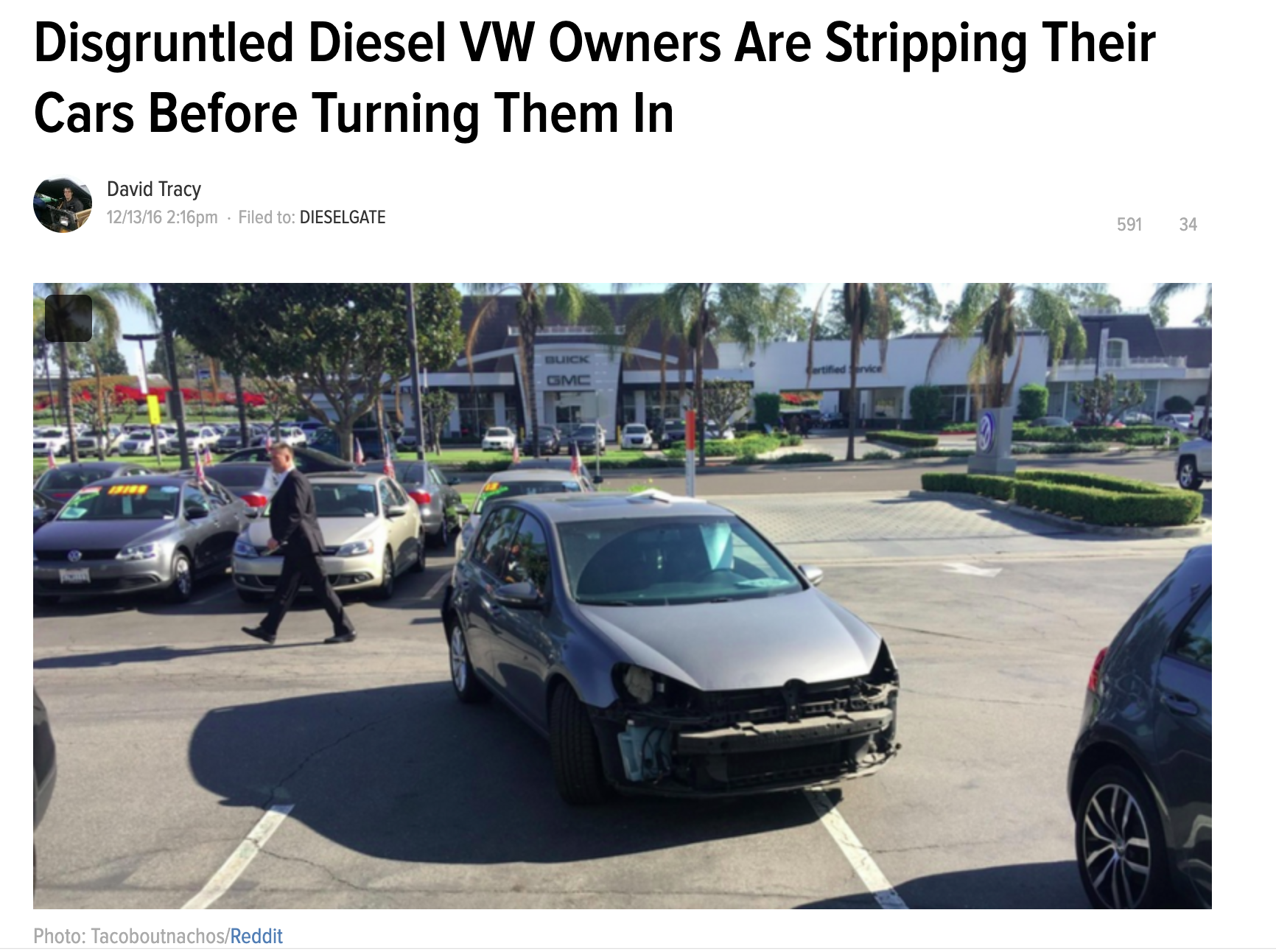
I’d spotted a bunch of threads on the TDI Owner’s Club and on Reddit where people were discussing stripping their vehicles, and in their defense, the buyback terms in the EPA’s Consent Decree only required that the vehicles be “operable,” as defined below:
“Operable” means that a vehicle so described can be driven under its own 2.0-liter TDI engine power. A vehicle is not Operable if it had a branded title of “Assembled,” “Dismantled,” “Flood,” “Junk,” “Rebuilt,” “Reconstructed,” or “Salvaged” as of September 18, 2015, and was acquired by any person or entity from a junkyard or salvaged after September 18, 2015.
One gentleman in particular, Joe Mayer out of Cincinnati, Ohio, was really going for it:
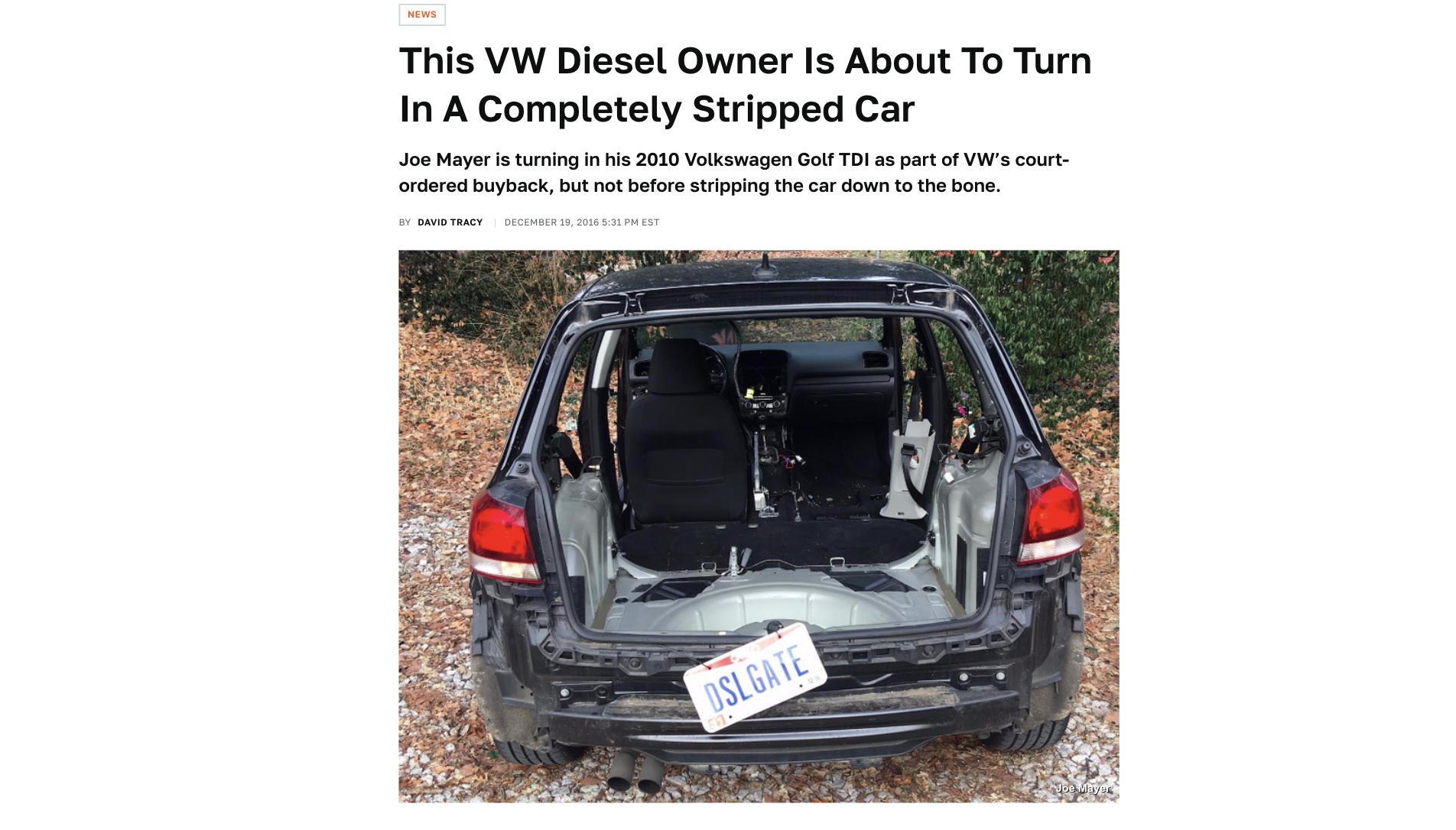
Here’s a bit of my conversation from Joe Mayer:
I called him up to see how serious he really is about trying to turn this stripped-down hatch in to the dealership, and he told me this isn’t a joke, and that he’s read the court documents and knows that the settlement terms only specify that the car has to be “operable,” i.e. that it can be driven under its own power.
Mayer bought his little diesel manual hatchback in the fall of 2015, just a few weeks before Volkswagen’s diesel scandal made headlines in September. In fact, he says he hadn’t even plated the car by the time the scandal broke, so when the time came to go to the DMV, he chose the “DSLGATE” license plate you see above.
After the settlement terms came out, and Mayer read that the condition of the car doesn’t affect the payout, he decided to remove a bunch of parts from his Golf, figuring “Why not make a bit of extra money?”
This story made waves, getting the attention of not only a number of other news outlets, but also of the judge overseeing what would become the largest automotive class action settlement in history. Here’s USA Today’s story on it:

I reported the full court discussion in this story:
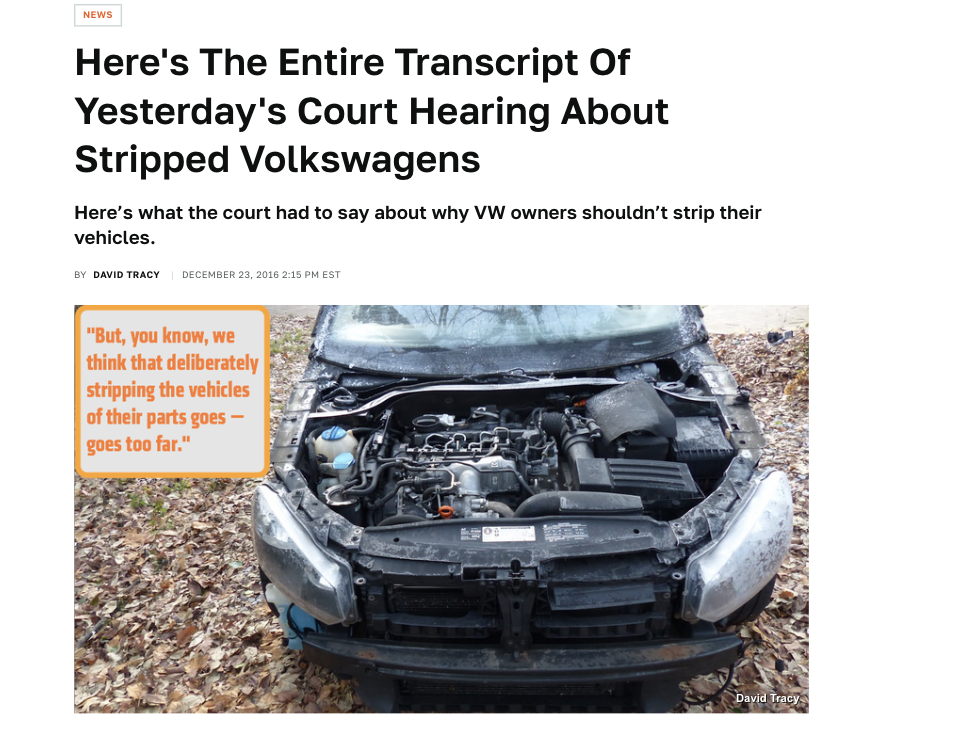
Yes, in the official Dieselgate court hearing, Volkswagen’s lawyer spoke with the judge about my article — and as a 25 year-old new journalist, I found this all quite exciting:
I wanted, your Honor, if possible, to flag one issue for the Court. While the great majority of Volkswagen customers participating in the 2-liter settlement have taken very good care of their vehicles. A handful of owners have brought in vehicles for buyback that have been regrettably deliberately stripped of parts. In fact, at least one owner went so far as to strip the car of almost every removable part, including seats, doors, a radio and even the air bag. Now, under the settlement agreement there was an allowance made for class members whose vehicles were in accidents or otherwise suffered from harm through no fault of their own. But, you know, we think that deliberately stripping the vehicles of their parts goes — goes too far. And, in fact, the buyback announced provided for in the agreement were based on the value of the cars as a whole, including their parts. So, respectfully, Volkswagen would ask the Court to advise class members that if they wish to receive settlement benefits,
And here was the judge’s response:
THE COURT: And I would echo that. I think — I think you’re absolutely correct, Mr. Giuffra. The amounts, the whole process was based upon what I would say the average car or at least the class of cars without the necessity of looking at each individual car. Because we’re talking about 400,000, 500,000 cars, it would have lengthened this process and complicated it enormously. And so I think — I think that not just in the spirit, but clearly the purpose of the agreement was to accept these cars by Volkswagen in the condition that they were — they were in as they were being driven on the road, and that’s — and not to strip the cars. And, obviously, if there is any concern in a particular case or it becomes a larger problem, the Court will address it upon motion of the parties. But I think that a word of caution is appropriate at this time.
This was maybe the first instance of me realizing the influence that I had as a journalist. The lawyer of the biggest car company on earth, and the judge overseeing a historic settlement — the third biggest ever, and the biggest in the car world — were making changes to their process as a result of my reporting!
The most exciting thing about all of this, though, came when I drove five hours from Detroit to Cincinnati to drive Joe Mayer’s stripped-down Golf TDI. Watch this:
Just look at me RIP that little stripped-down Golf through those Cincinnati streets. With the doors and rear hatch off, and much of the interior gone, the thing probably weighed about 2,500 pounds, and with 140 horsepower and an absurd 236 lb-ft of torque going through a six-speed manual, the thing was just a destroyer of front tires — a true beast.
Getting to drive Joe Mayer in Cincinnati was a true thrill, but the response from the judge overseeing the largest automotive class action case in history came quickly, and Joe stopped wanting to talk about his car, presumably because he was concerned he’d be denied the ability to be a class member in the settlement. Of course, not everyone followed the rules; I had a chat with a reader named Ellis, who decided to have some fun rattle-canning his car. From my article below:
Ellis told me over the phone that he figures, since his car is a “Gen 1″ 2010 model for which VW isn’t likely to find a fix, it’s destined for the junkyard anyway. So he thought he’d have a little fun, and impress his three and seven year-old daughters with a pink paint-job.
But while his girls love the Jetta Sportwagen’s new look, the buyback specialist at the dealer apparently did not, emailing her supervisor and telling Ellis he may have to repaint the vehicle.

Me Discovering A Huge Stash Of Dieselgate Cars Caused All Sorts Of Chaos
Another story that made waves happened after a former Chrysler engineering coworker told me they’d seen a bunch of VW Dieselgate cars parked at the then-abandoned Pontiac Silverdome, where Chrysler parked many of its development vehicles. I visited the site and took a few photos;
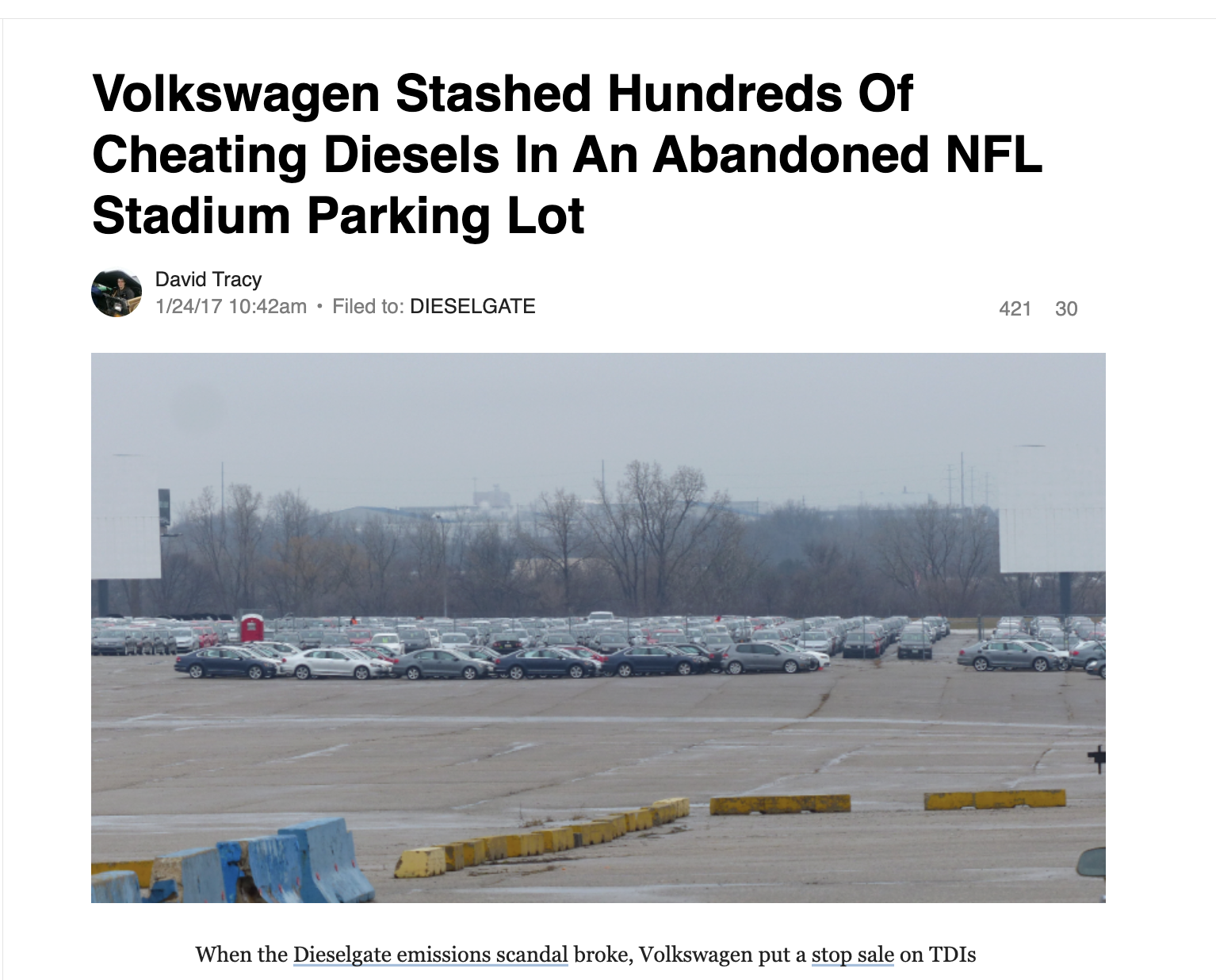
After that article, a number of news outlets wrote their own stories, with Michigan’s Local 4 News channel, ClickOnDetroit, actually interviewing me for TV:

I’d like to just point out that the photo they used of me is a cropped version of this:

Thank goodness they cropped it!
Only a few months after I published the whereabouts of all those cheating Dieselgate cars, the city of Pontiac filed a lawsuit against the owners of the Silverdome for “violations of the building and safety code, zoning ordinances and municipal code” associated with the stored VWs, per The Oakland Press. I wrote about it here:
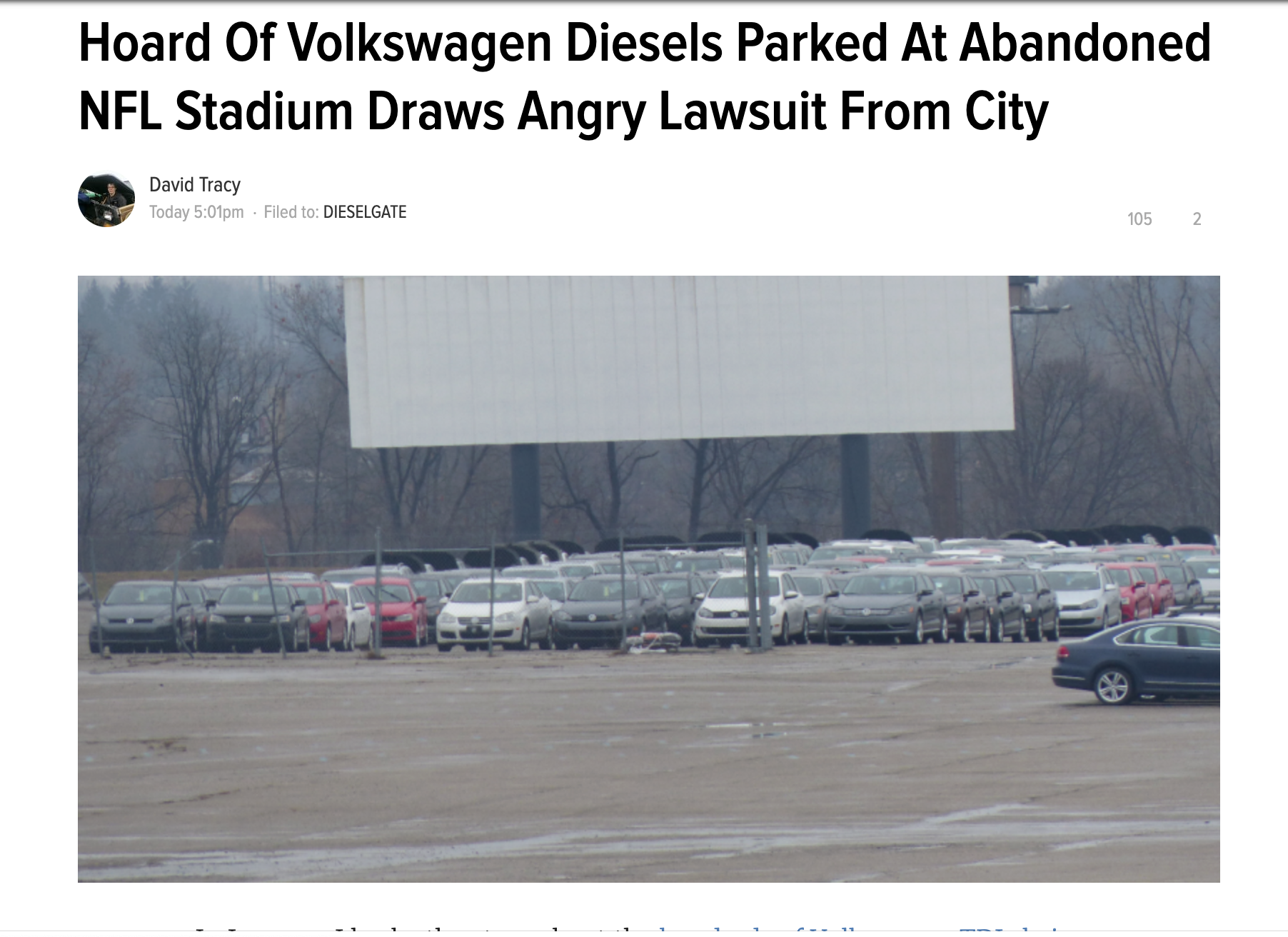
A few months later, someone went to the Silverdome and stole a bunch of the cars!:
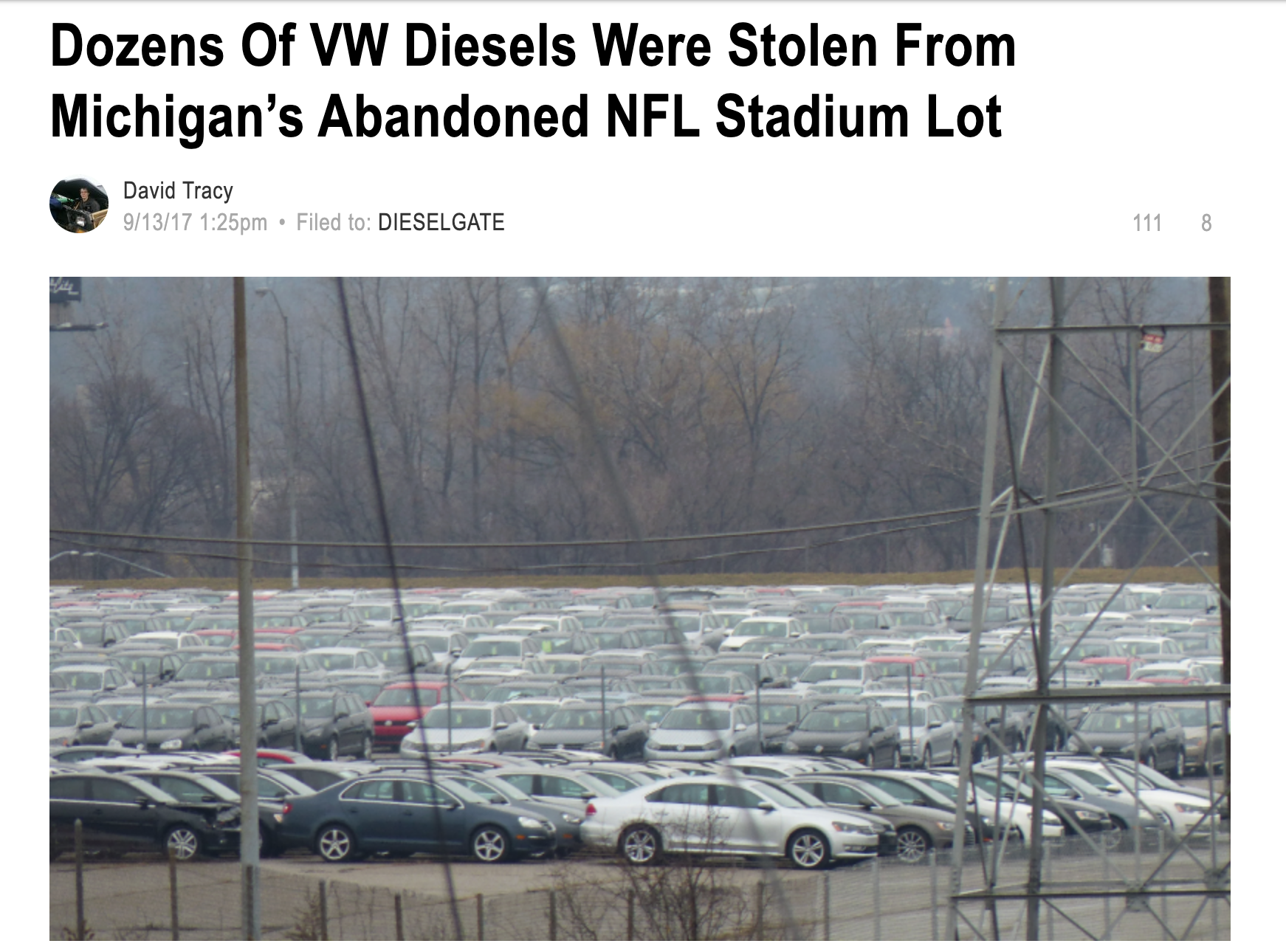
Then, a few months later, I wrote in The Morning Shift about the crime-ring facing jail time for the alleged theft:
Eight months [after my article showing the Dieselgate cars at the Silveradome], we learned from Louisville-based news site WDRB that over 60 of those cars had been stolen, and some even re-sold in Indiana.
Now two men—a 42-year-old and a 41-year-old from the Detroit suburbs of Farmington Hills and Eastpointe, respectively—have been charged, and could face up to a decade in prison if convicted of “sale or possession of stolen motor vehicles,” and up to five years in the clink if they’re convicted of a conspiracy charge, the Detroit News writes.
The news site describes how the operation allegedly went down:
“The duo recruited others to steal the vehicles from the Silverdome parking lot, according to the indictment. The vehicles, including Volkswagen Touaregs, Audi Q7s and Volkswagen Passats made between 2011 and 2015, were loaded onto transport vehicles and hauled to other states, including Kentucky and Indiana, according to the government.
At least one vehicle was shipped out of the country.
The Detroit News quotes authorities, who had a few words to say about the situation:
‘These individuals were bold in their behavior in stealing such a large volume of vehicles from a well-known location,’ Oakland County Sheriff Michael Bouchard said in a statement. ‘These criminals deserve to be punished to the fullest extent of the law.'”
That escalated quickly.
I Wrote Lots Of Really Detailed Explanations Of How The Buyback Works
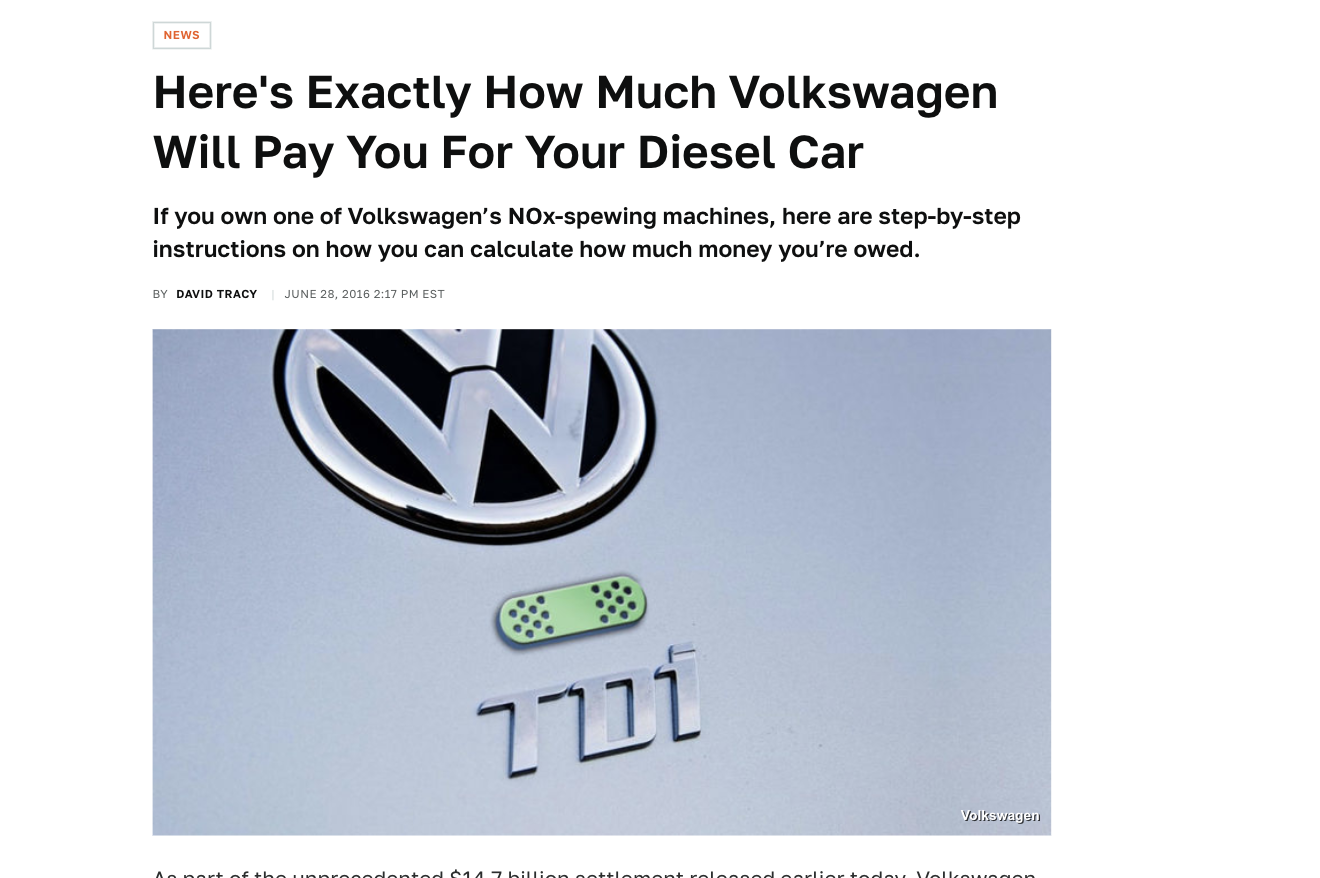
As an engineer, I enjoy diving into complex spreadsheets, so when the court finalized the settlements for the 2.0-liter and then the 3.0-liter, I was sure to dig into how they worked. I’m not going to get into the details here, but here’s a quote from my 3.0-liter buyback explainer:
Like the 2.0-liter cars, that buyback amount is meant to represent the value of the vehicle prior to the depreciation caused by the Sept. 18, 2015 Dieselgate scandal announcement. The court calculates this buyback value as simply the National Association of Auto Dealer’s Clean Trade-in value published in the Sept. 2015 NADA Used Car Guide, adjusted for factory options, mileage and geographical region.
That mileage adjustment assumes owners drive 15,000 miles a year. So if someone turns their vehicle in on Sept. 18, 2018 (three years after Dieselgate broke) with 100,000 miles, the Clean Trade-In value for a 55,000 mile vehicle would be used to devise the buyback amount. Buyback amounts for generation one vehicles range from $24,755 to $57,157.
The restitution payment, which is meant to compensate owners for being duped into buying a car that was marketed as a “Clean Diesel,” is a cash payment guaranteed to all generation one class-members, in addition to a buyback or modification. It is calculated as $5,155 plus a variable component, which is defined as:
(i) the amount by which Vehicle Clean Retail Value exceeds Vehicle Value; plus (ii) state and average local taxes on the Vehicle Clean Retail Value…
The quote above boils down to, essentially, the difference between what someone could pay for a car on the dealer’s lot and what someone could trade the car in for. Take that number, add state and local taxes, then add $5,155 and you end up with your restitution amount. Restitution amounts for generation one cars range from about $7,755 to $13,880.
This story, incidentally, was quoted by the official “Transcript of the February 14, 2017 Preliminary Approval Hearing,” where the court was discussing the media’s reception to the proposed settlement:
And a very popular website that a lot of car enthusiasts go on called Jalopnik, which is an interesting name but it’s actually a very popular site, made a very interesting observation in their review of the settlement. They are saying, after noting when it’s all going to start — they say, “After it starts, if you own a 2009 to 2012 Touareg or Q7, you can sell your car back for big money,” they note, “and then receive a hefty cash restitution payment. And if you’re a Generation Two 3-liter diesel owner, you may be able to get your car fixed entirely and still get some cash.”
My big deep-dive on the buyback, “Here’s Exactly How Much Volkswagen Will Pay You For Your Diesel Car,” was the internet’s most detailed buyback explainer and included a bunch of fun tables like the ones below from “FTC’s Proposed Partial Stipulated Order for Permanent Injunction and Monetary Judgment.”
The first showed owners how to determine their buyback amount based on the year, make, model and trim. The second table discusses the “mileage adjustment” (lower mileage cars were, of course, worth more):

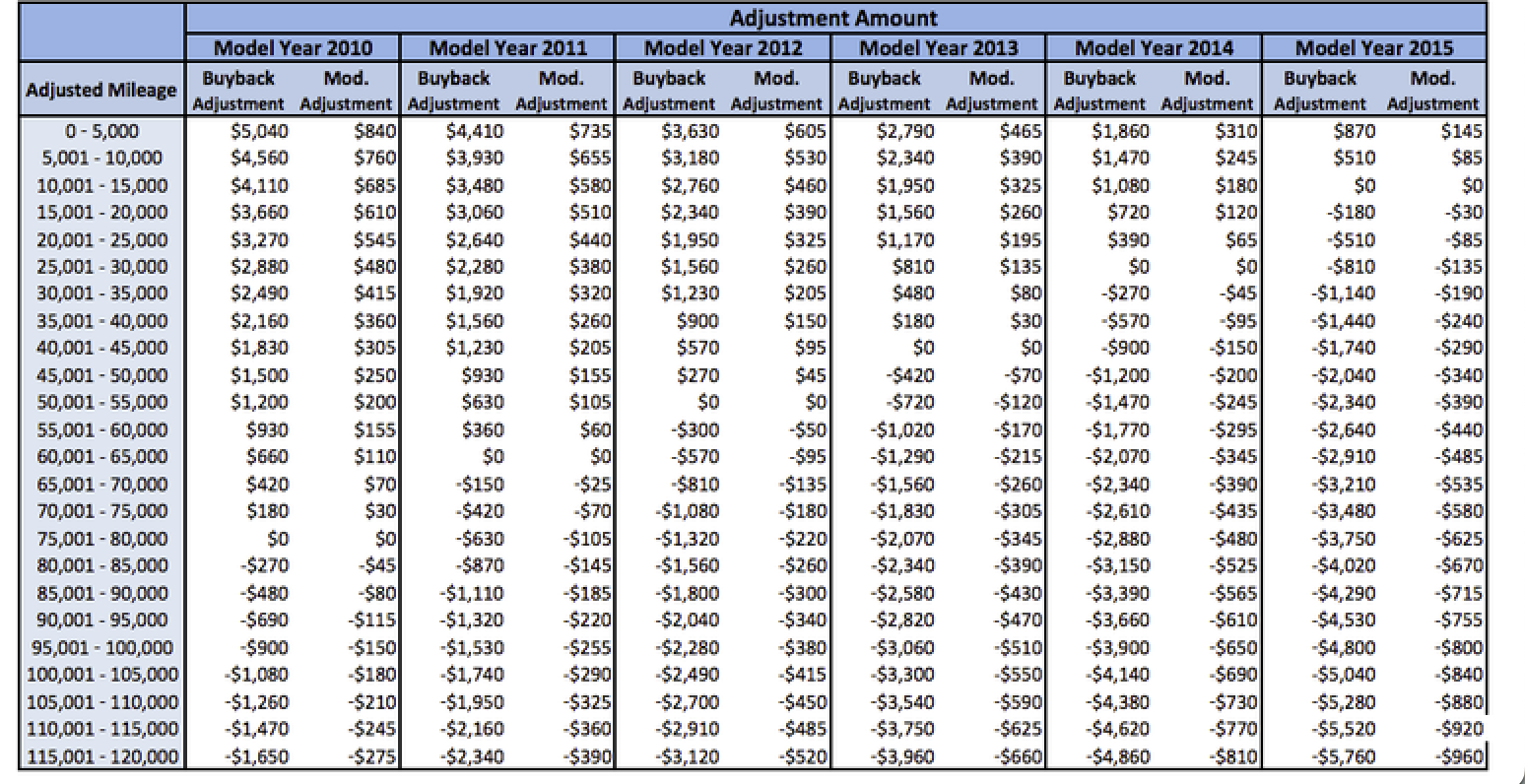
My deep-dives were mentioned in the official court documents, including in the Motion for Final Approval:
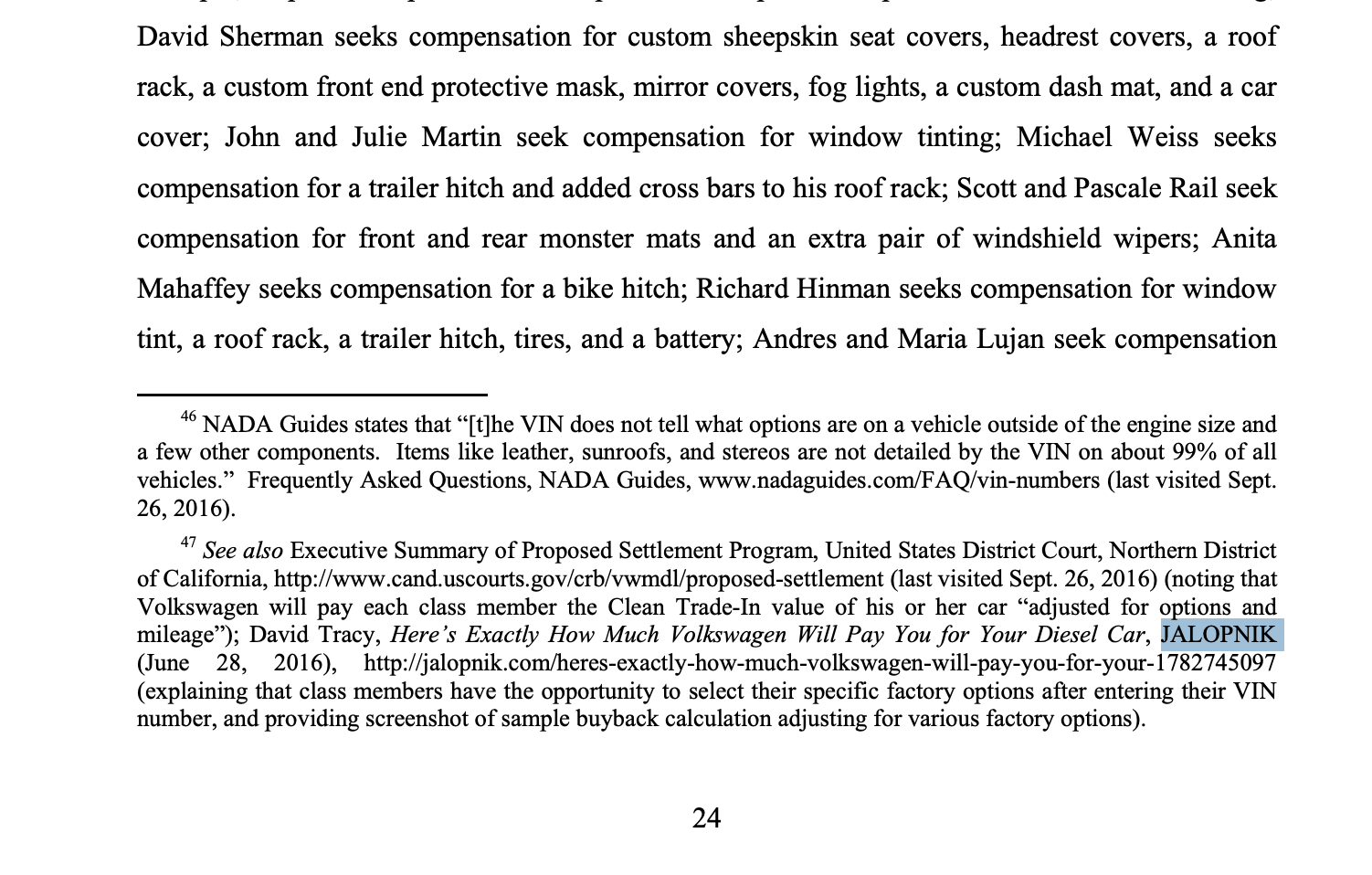
I Did A Q&A With The Head Lawyer, Elizabeth Cabraser
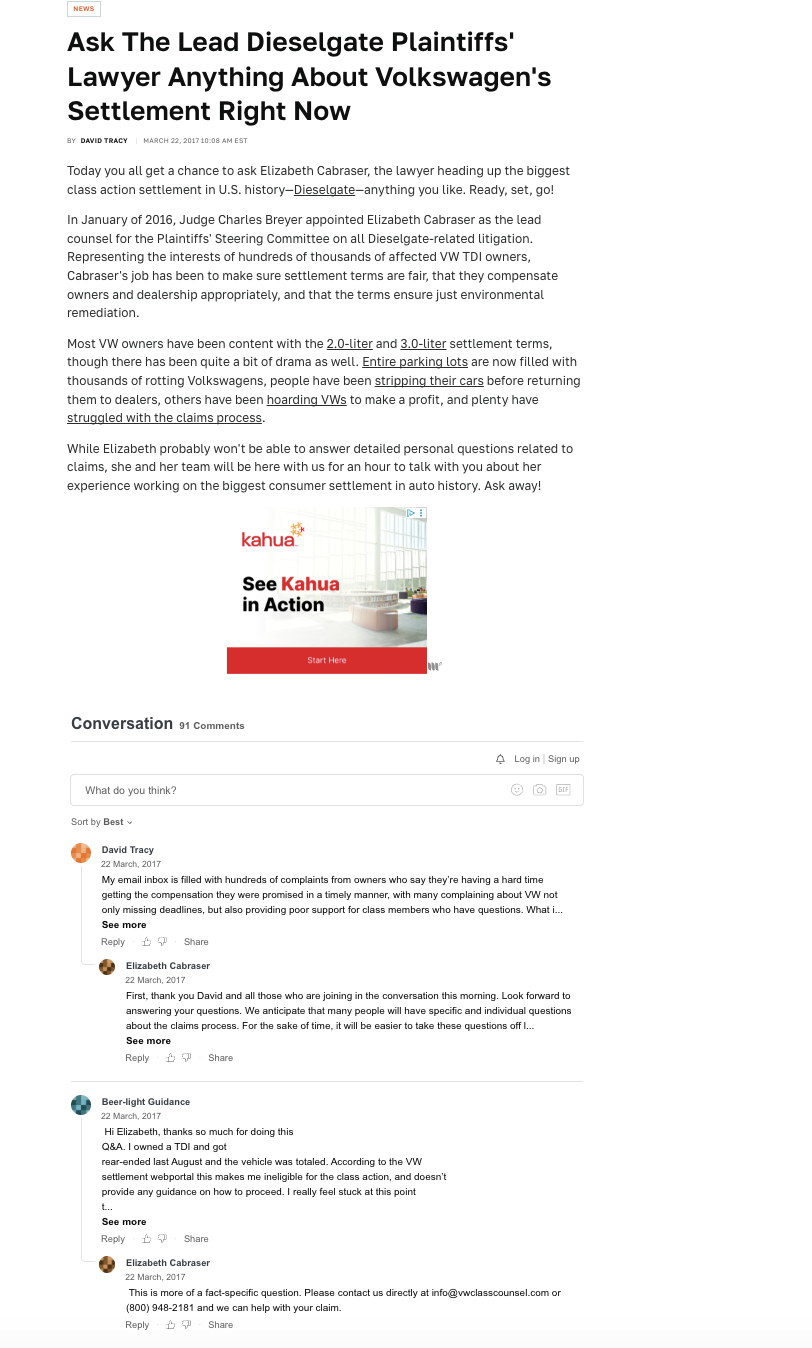
To help owners understand what was going on, I hosted the head of the Plaintiff’s Steering Committee, Elizabeth Cabraser. She even mentioned the Q&A in court, specifically in the Final Fairness Hearing for 3.0-Liter and Bosch Settlements, saying:
So we know from the comparison of the queries we got from class members, the information we provided them in response, which would range from emailing them the complete settlement agreement, to the Long Form Notice, to the executive summary, to transcripts, going on a discussion group with Jalopnik, for example, that a number of provisions were of interest to different class members. We tried to give equal dignity, equal emphasis, and equal attention to all of the key provisions.
Once The Buyback Terms Were Finalized, People Started Making Huge Money Hoarding Cars
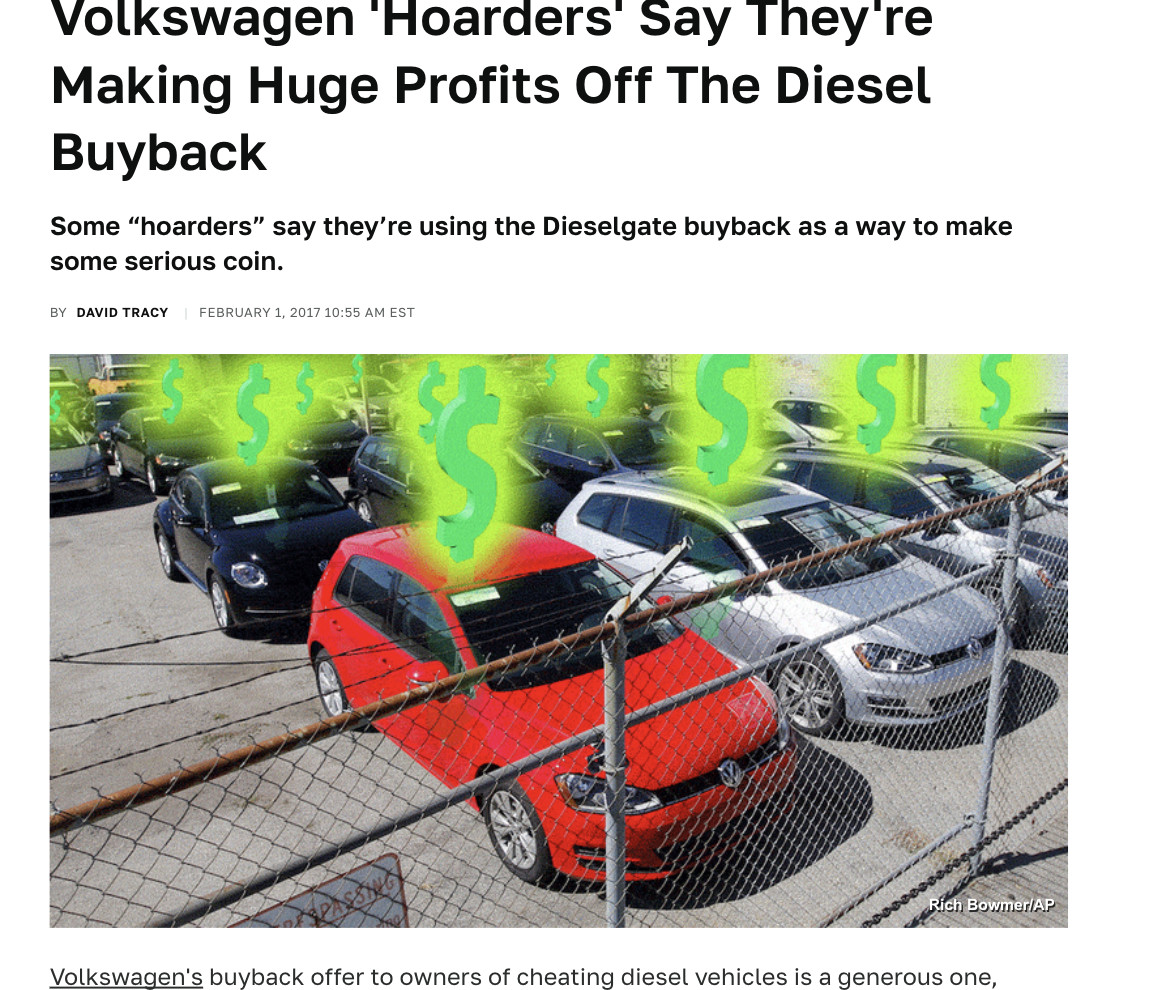
When Dieselgate first happened, I remember my colleagues and I talking about what was likely going to happen. There would have to be some kind of buyback. “Man, maybe we should just buy up Dieselgate cars,” we joked.
We should have done just that, because as I reported in the story shown above, people made beaucoup bucks buying cars and having VW buy them back. From my story “Volkswagen ‘Hoarders’ Say They’re Making Huge Profits Off The Diesel Buyback“:
The first person I called said he’s bought 10 used TDIs expressly to resell to VW to make money. He told me he expects a 55 percent return on investment, with a total projected buyback (based on VW’s online claims portal) netting him $60,000 in pure profit. That’s a lot of money from just buying and storing 10 vehicles.
His two most profitable cars, he says, were a 2011 and 2012 Jetta. He bought the first for $7,900 after tax, title, registration and insurance costs, and it is slated to fetch him $15,300 from VW, for a profit of $7,400. Thanks to the cheating scandal’s toll on the cars, those who got in early got the cars for cheaper than they would have pre-Dieselgate.
[…]
The second person I called, with the username SoloNoMore, also chimed into one of the threads saying he was “sitting on 25 or so [TDIs] now” (he lost count).
So far, it seems it’s working well for him, as he wrote in another thread:
I also right now am rolling with more of them than I can even keep up with, turned in the first batch last week and all went smooth. You’ll reap you reward! No quicker way to double or triple your net worth than a nice ol fashion TDI buyback in your life.
After talking with him on the phone, I learned that “25 or so” has actually grown quite substantially, as he told me he’s been buying up to 10 TDIs per day on big dealer auction sites like Adesa and Manheim. Speak of which: in the background of our conversation, I could hear a live auction taking place; SoloNoMore told me he was literally bidding on TDIs as we spoke.
I Interviewed Owners Who Missed Their Cars
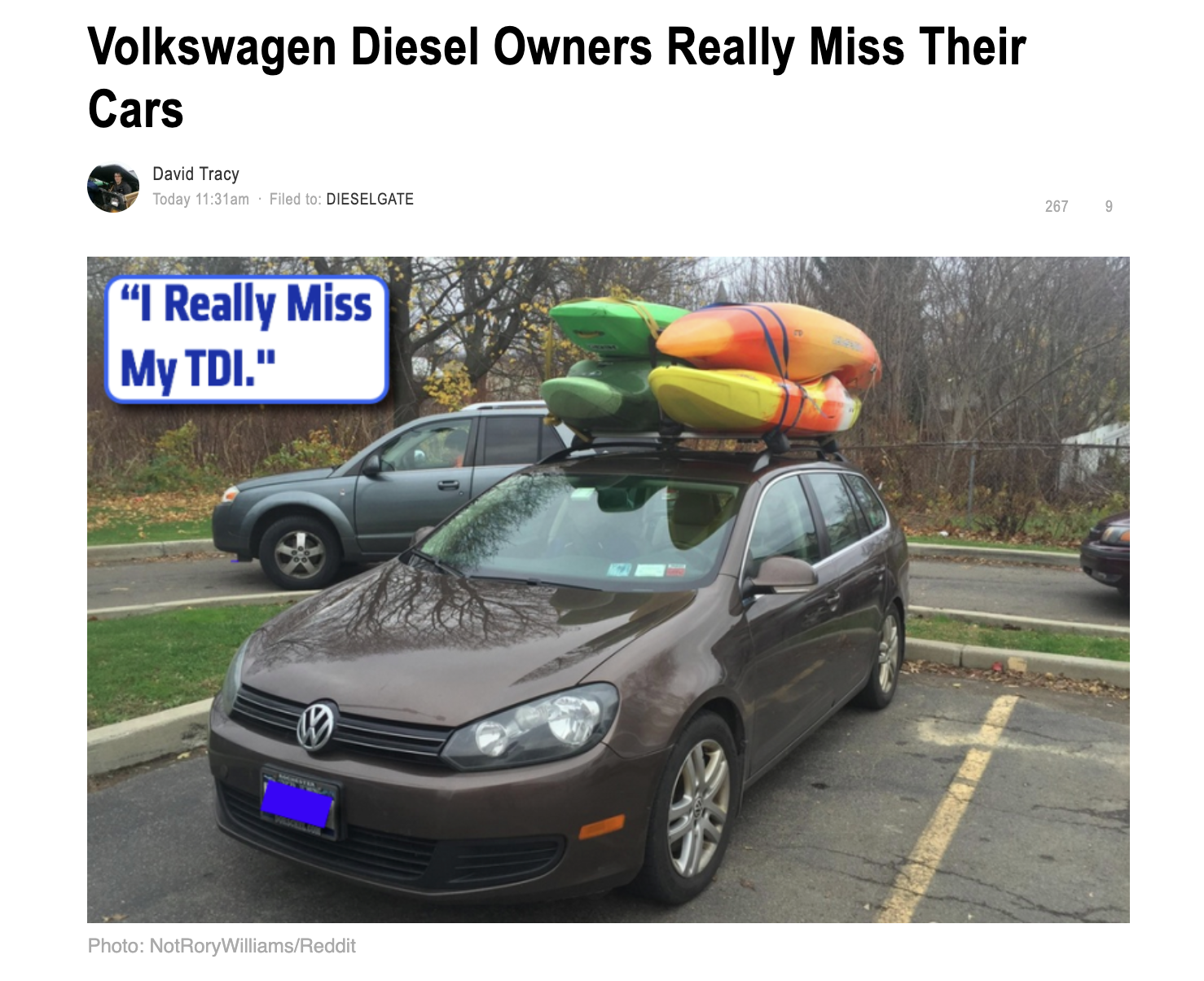
One of the sad things about Dieselgate is that the cars themselves were phenomenal — safe, fuel efficient, practical, reliable. Their owners loved them, which is why some struggled to part ways with them. From my story “Volkswagen Diesel Owners Really Miss Their Cars”:
I’ve come across quite a few forum posts, Reddit posts and emails from folks who just miss their TDIs. No, they didn’t technically have to sell them back, but that handsome buyback check was impossible to pass up. Still, even with fat pocketbooks, these folks’ hearts are hurting, and I totally understand why.
Here’s a post on Reddit by NotRoryWilliams entitled “I really miss my TDI” (that’s his car in the picture above), which includes “obituaries” from a number of other TDI owners. NotRoryWilliams wrote the obituary for his 2011 Jetta Sportwagen to me via private message, saying:
It was simply the best car I ever had. It was really well designed and well built. Aside from the gas mileage, which was amazing, it was fun to drive, comfortable, quiet, and really capable. It had no problem supporting week-plus road trips fully loaded with all of my whitewater kayaking and mountain biking gear as well as camping gear, and a few people too.
[…]
Jalopnik reader Matt, who sent me an email about his quest for a TDI replacement, told me there really just isn’t anything out there that can compete with his Sportwagen, so he’s struggling to decide whether to keep it, writing:
I have a 2.0L affected by all this cheating stuff. I considered the buyback, but I quickly discovered there are damn near zero decent family cars for sale in the United States. (Off topic, but seriously, just try looking for a well-handling wagon with a manual transmission. It turns out we already own a better family car than anything else we can buy new today).
[…]
Redditer bentripin’s story is probably the most heart-wrenching of the lot, as it chronicles the many journeys he took with his dream car, a Golf TDI:
Going to really miss mine when I give it back in 2 weeks; it too is the best car I’ve ever had.. When my Wife and I were dating over 10 years back we went on a big west coast national park road trip in my MK4 GTI; I dreamed of having a diesel with a lil trailer that trip..
What I Learned Being A Leading Reporter On Such A Historic Settlement
What a wild ride all that was. From heading to Cincinnati to drive a stripped car that would lead the judge for the historic settlement to make a new rule; to folks stealing over 60 VWs after I reported that VW was stashing them in an abandoned football stadium parking lot; to being cited in numerous court documents for the deep explainers I wrote about how the settlement works; to hosting the main lawyer representing VW owners; to interviewing people using the whole situation to get rich; to interviewing others who just miss their cars — the whole thing was a roller coaster.
It was a reminder of just how much influence a journalist can have, and how important it is to wield that influence responsibly. The chain reactions that occurred because of my articles about the stripped cars and about those cars at the stadium were substantial. Judges and lawyers and citizens were listening to my every word, and those words were causing people to act.






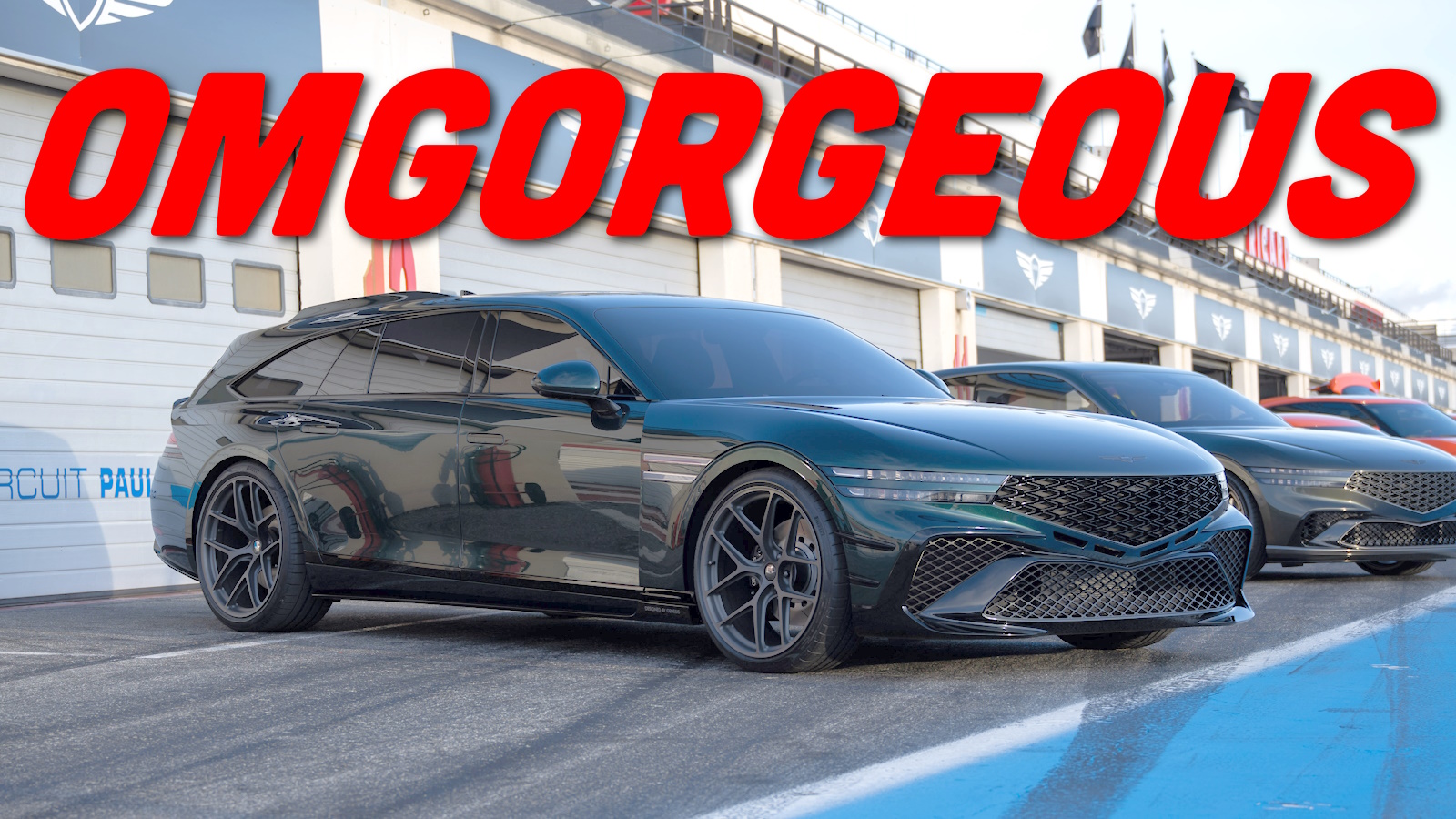

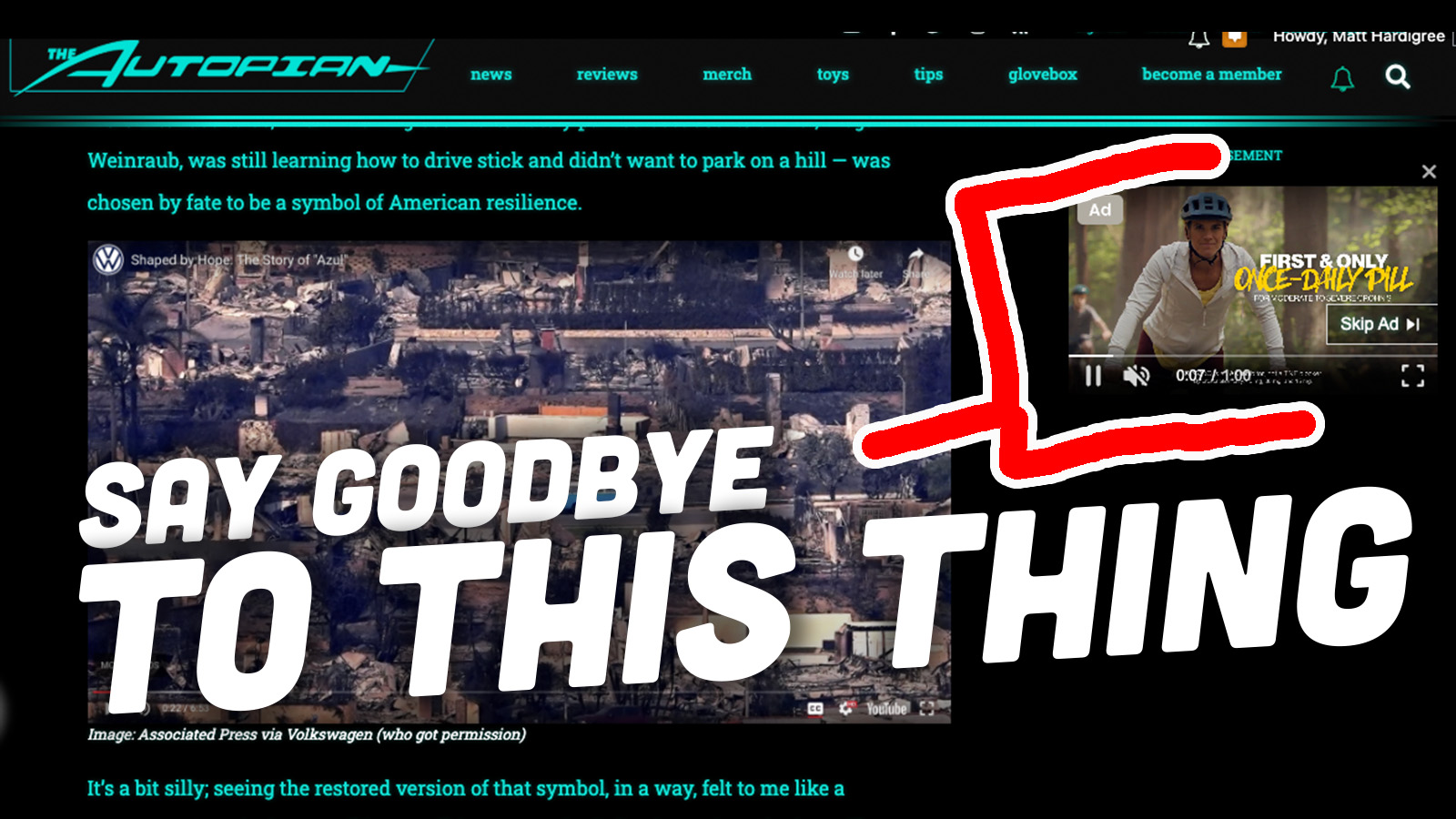
Yeah, right. You always say you are just a blogger and are not responsible for lies in your “stories” (because they did not happen)
Weird to see my post from over 8 years ago screenshotted in the middle of the article. The rest of the story is that not only was she unhelpful in her response, but my emails and phone calls went unanswered and unreturned.
I eventually got all the money I was owed but no direct thanks to Ms. Cabraser or her team.
Honda managed to make a Civic that didn’t need a catalytic converter back in 1975 or so. Did they cheat? Who knows.
I had a (chipped) 2001 Jetta TDI that passed all of Washington’s emissions tests for 14 years and once I move there, Texas didn’t even bother to test it, maybe because a lot of coal-rollers wouldn’t have passed.
The test for diesel cars in Washington was based on the Ringelmann Scale, which was just a measurement of the opacity of what came out of the tailpipe.
The abandoned and venting oil and gas wells in the Permian Basin in west Texas probably do a lot more damage to the environment than a bunch of Volkswagens across the country. But. Yeah. Texas. Maybe they are #2 behind Florida man.
And then there is China. Back then, they were a significant contributor to air quality issues on the US west coast. Have they cleaned up their act?
China still burns a lot of coal but they are turning the.corner to renewable. A mind boggling statistic is China installed 100 solar panels per SECOND in May 2025.
Meanwhile, the current US administration is doing everything they can to halt renewable energy generation.
Trump administration halts wind project in Rhode Island
Yet another way the US is falling behind China. And, yes, that is a mind boggling statistic.
I just don’t get it.
It likely won’t make a big difference in my lifetime, but I actually do care about the planet being left behind for subsequent generations.
Speaking strictly in passenger vehicle terms, yes. China first implemented emissions regs in the year 2000 with the China 1 standard, which is based on Euro I. Iterating Euro standards on a ~4-5 year cadence, China caught up to Europe with the China 6a standards which match Euro 6 in 2021. Euro standards are more lax on NOx, particulates, and hydrocarbons than US EPA, so China implemented stricter limits (unsure if equal to EPA) on those with China 6b in 2023. These regs apply equally to diesels and are also applied to municipal vehicles like sanitation, postal, busses, etc; not sure what the size threshold is though.
As we know, China is also now the world leader in NEV adoption, and policy & fuel pricing has made PHEV users home charge daily at a high rate, unlike Europe.
Power generation is a mixed bag. They’re making huge expansions of renewable wind, solar, BESS, and hydro while building a good number of coal plants, but makes the proportion of coal generation’s contribution to the overall grid drop. Progress?
It was a reminder of just how much influence a journalist can have, and how important it is to wield that influence responsibly. The chain reactions that occurred … were substantial. Judges and lawyers and citizens were listening to my every word, and those words were causing people to act.
To my mind, these were the most
dangerousimportant words in the entire article.